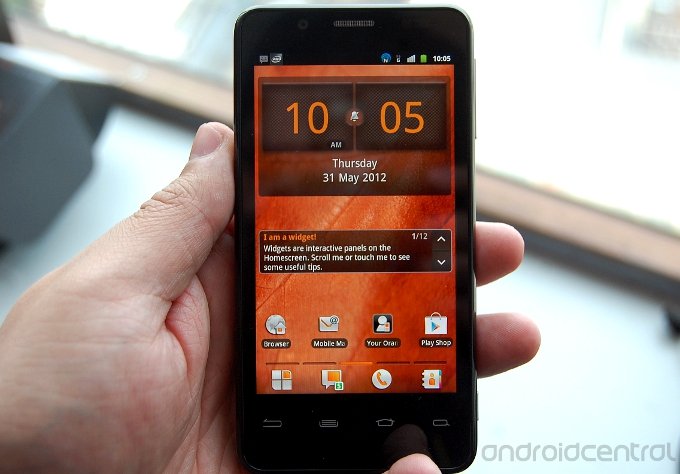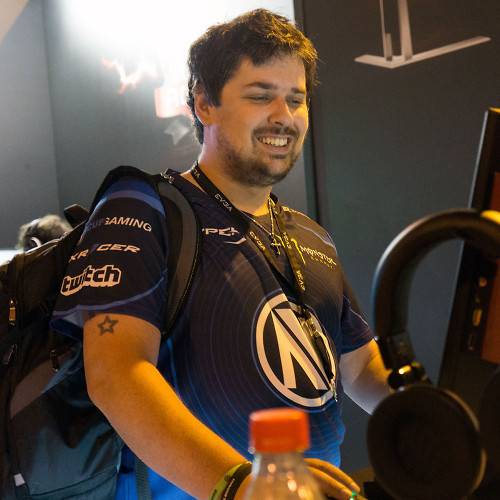Orange San Diego hands-on and first impressions

Down in jolly old London Town this morning, Orange UK threw a little breakfast soiree in a venue 31 floors up. The purpose? To officially unveil their latest own-brand Android smartphone, until now known as the Santa Clara. Traditionally, Orange has piggy-backed onto a device from the likes of ZTE, offering a budget device geared towards the low end of the market. They're also not usually the sort of devices that warrant gathering members of the press in the center of London at breakfast time. With their latest offering -- launching as the San Diego, so keeping to the city name tradition -- the carrier is going about things a little different. There is something to shout about -- Intel Inside.
More: Orange San Diego hands-on video and photo gallery
A little background for those who may not be familiar. Intel unveiled the Medfield platform back in January, at CES in Las Vegas. During the keynote presentation, a Gingerbread based, reference device was put through its paces in front of the gathered media. The results were pretty impressive. Browsing speeds were excellent, battery life touted as better than the multi-core competition. The device announced for launch was a Lenovo handset, the K800, which has just launched in China. Since then, the San Diego was announced in the run up to MWC in February, and the Lava Xolo -- the twin sibling of the San Diego -- was launched in India.
Fast forward to today, and our first hands on with a finished Intel-powered Android smartphone. The San Diego is the first Intel device to launch in the UK, and in Europe for that matter. It's well priced too. On pay-as-you-go you're looking at £199.99, and on contract the San Diego will be free on a 2-year deal starting at £15.50 a month.
We're no longer really referring to it as Medfield either. The processor inside the San Diego is a single-core, 1.6GHz Intel Atom Z2460. Rolls right off the tongue, doesn't it. HSPA+ support is along for the ride too, so you'll get the fastest data speeds Orange currently offers. It's made of plastic, as you would most probably expect for a cheaper device, and the front is a real fingerprint magnet. It is very light though. The HTC One X I carry daily is un-naturally light, but because of the materials used in its construction, it feels like a premium feature. With the San Diego, the construction isn't so premium, so it leaves it feeling a little cheap.
Running through the specs quickly -- we've posted them already earlier today -- there's an 8MP rear shooter with burst mode that is capable of shooting 10 frames per second. We also get 16GB internal storage, a 4.03-inch display at 1024x600 resolution, 1GB of RAM and compatibility with Orange's HD voice system for "crystal clear calling," which for what it's worth, is excellent. And, finally, it runs Android 2.3.7. Yes, it runs Gingerbread.
And that's where we'll begin. Yes, it runs Gingerbread, and no for a lot of people that isn't OK. For anyone who has tasted Ice Cream Sandwich, it's pretty much impossible to go back. Does it taint the San Diego? No, not really. Had it launched with ICS, it might have been a real showstopper at this price point, but the fact is simple. Many of the likely buyers of this phone, will not have a great deal of interest in which version of the OS it's running. That and they won't likely have used an ICS phone yet either. Value for money, battery life, a decent camera, all these rank higher. So long as the overall experience is good, version number shouldn't dictate whether or not somebody wishes to buy this phone. And, the experience is good -- in all honesty, a lot better than I was expecting. Value for money is a key term, not just price, but what you get for that price.
Be an expert in 5 minutes
Get the latest news from Android Central, your trusted companion in the world of Android
Don't forget though, that Gingerbread has been highly optimized for the Intel platform. That said, there were several whisperings of an ICS update coming later in the year, but no-one I had chance to talk to could confirm, deny or really say anything on the matter. Everyone has to start somewhere, and Intel, despite being the massive name they are, still need to prove themselves in this space. There's no point hitting for the One X end of the market without first proving your worth a bit lower down. High end performance on lower end equipment.
Keynote presentations are supposed to show a device in great light, but the San Diego is every bit as smooth as Intel told us it would be. Truth be told, it's an incredibly speedy device to use. There is not a noticeable trace of lag as you navigate through the launcher, the app drawer, the menus, flicking between apps, you get the picture. The Orange custom UI isn't particularly intrusive, it's just very, very, well orange. Each to their own tastes, but a custom launcher would be going on mine as soon as it came out of the box. We all know why it's orange, but it's a very harsh looking interface, especially when the icons for all the stock apps have been orange-ified as well. It's the same story with widgets, there's a variety of "Orange Widgets" which really are best left alone.
The usual apps are all on board out of the box, as are Orange's own such as their account management app, the Orange Wednesdays app and Orange Maps. Better than Orange Maps -- by a long, long way -- is the included Navigon sat-nav application. The maps come pre-installed on the phone, which is a truly excellent thing to get free of charge, when you consider Navigon UK retails for £39.95 in Google Play.
Let's move on to the screen. Considering everything, price, target market, the screen is absolutely gorgeous to look at. The resolution seems just about right, it's bright, colorful, and genuinely a joy to look at. This comes from a One X user. It isn't in that league, but when you consider the sort of devices competing at this price point, it is remarkably good.
Then we come to the camera. The 8MP camera on the back is capable of 1080p video recording, although is set to 720p by default. When taking still photos, the burst mode is capable of snapping 10 frames in just under a second. I'd like to be able to offer a definitive opinion on picture and video quality, but press event lighting is never a good setting to judge. For that, we'll have to wait to spend more time with the device.
That, will hopefully start next week. The San Diego will go on sale online and in retail stores on June 6. Surprisingly, I'm planning on buying one. There's a real sense of intrigue over what Intel can really do. Will as many apps as they claim, actually be compatible with the device? Just how good is the camera? But, perhaps the biggest question of all, battery life. Battery life is an ever increasingly hot topic, and the claims from Intel are that their devices will last. But we can't take their word on that. So, as an Orange customer, and a pretty heavy smartphone user, I'll be putting one through the ringer.
To wrap it up, the San Diego is actually a surprisingly nice device to use based on the short time spent with it. It left enough of an impression to want to test it out fully. The hardware is OK, nothing spectacular, but it does what it needs to do. Underneath is where it's at, and on the face of it every claim Intel make about how good their chips are, seems to have some weight behind. Orange is going to market the daylights out of the San Diego -- it will be the first of their own-brand devices to have television advertising. A big part of that advertising will be the Intel Inside badge that sits proudly on the battery cover. An instantly recognisable brand, a good user experience, and a good price to go with it.
Consider this also. The San Diego is in a similar price bracket to the Motorola Motoluxe I reviewed a few weeks ago. While the Motoluxe is considerably better in terms of out and out build quality, the difference in user experience is vast. Which lead me to a final thought as I left London.
Intel have also partnered with Motorola. If the San Diego had the build quality of the Motoluxe yet maintained the price point both devices are marked at, then, well. It gives us something to think about for the future.

